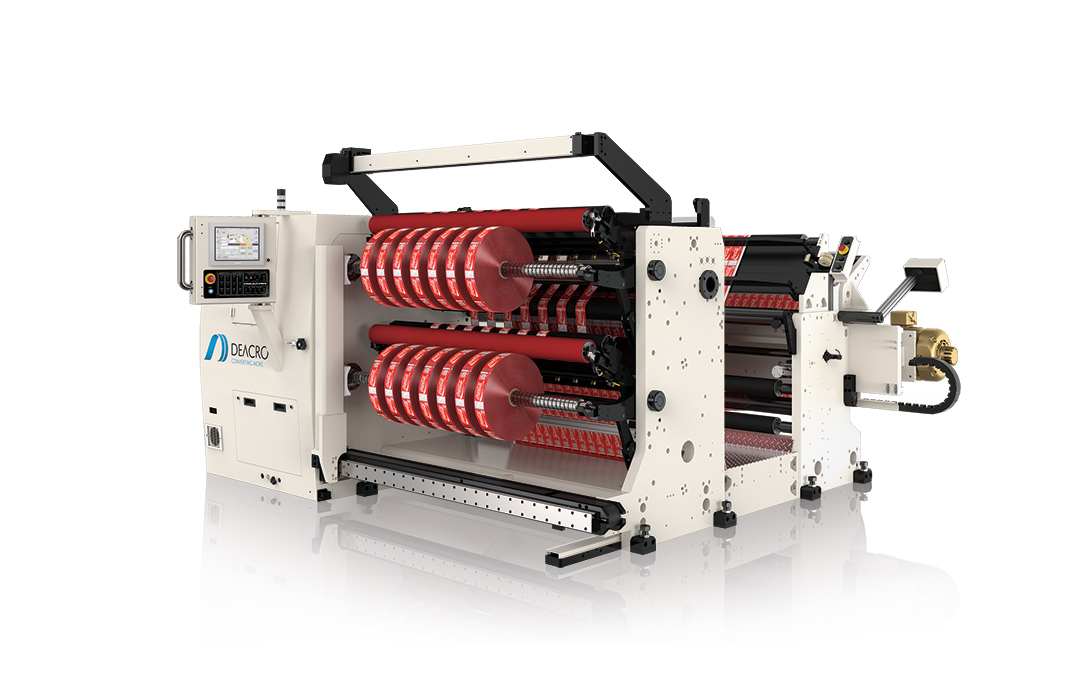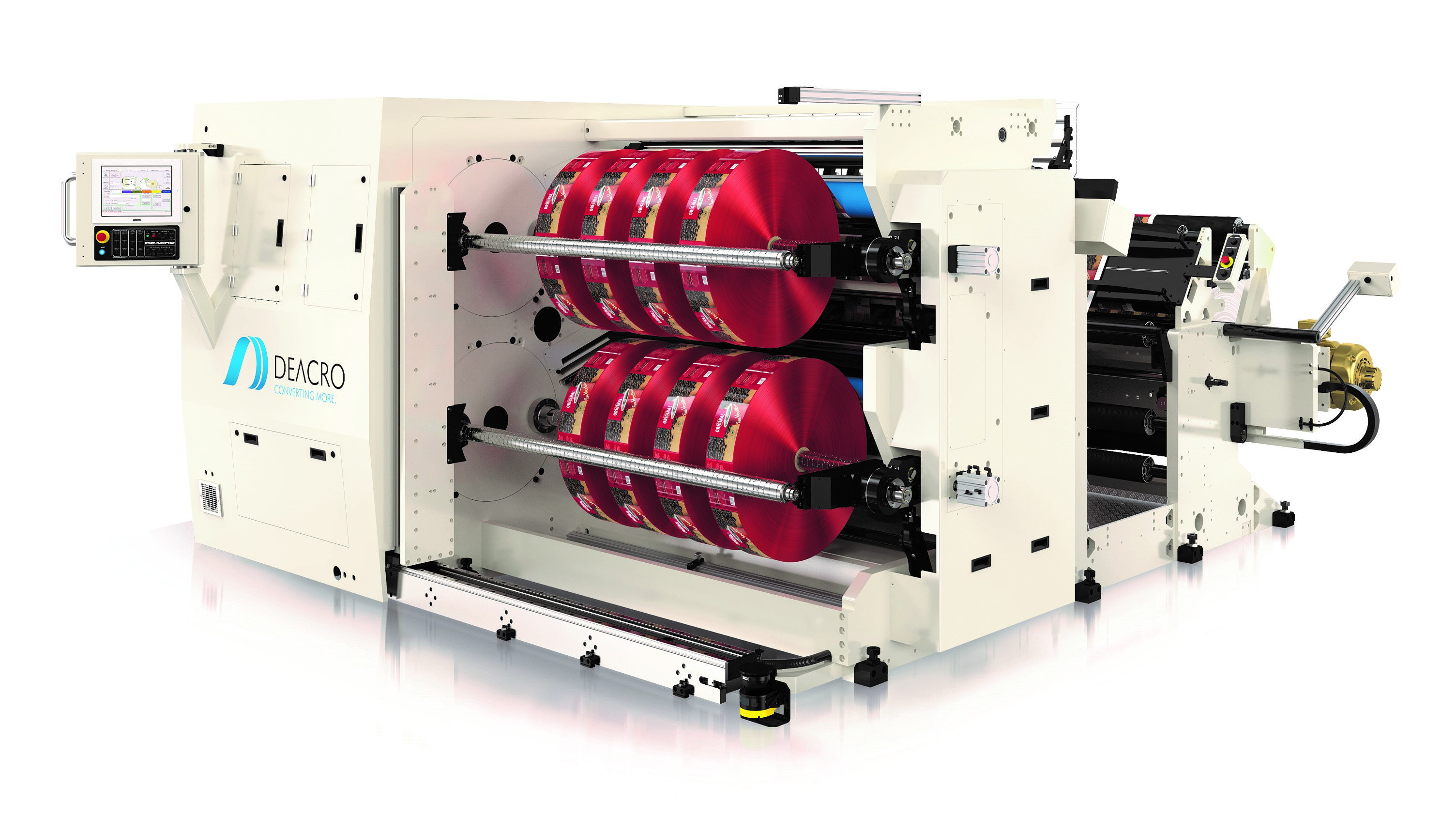Increase Productivity with Slitter Rewinder Automation
- Published: April 13, 2021
By Keith Hamilton, Sales Manager, Deacro Industries
 Converters continually face the pressure of achieving profitability in a competitive marketplace with tight margins. There is also the challenge of addressing market demands, especially in high-growth industries such as flexible packaging. Ensuring optimal equipment performance, capacity for existing and new products, and operational efficiencies are key to business growth, material savings and better products. One of the most crucial, but often overlooked aspects of the converting process is slitting and rewinding.
Converters continually face the pressure of achieving profitability in a competitive marketplace with tight margins. There is also the challenge of addressing market demands, especially in high-growth industries such as flexible packaging. Ensuring optimal equipment performance, capacity for existing and new products, and operational efficiencies are key to business growth, material savings and better products. One of the most crucial, but often overlooked aspects of the converting process is slitting and rewinding.
Why is the slitter rewinder so important? Simple. For most converters, slitting/rewinding is the final stage in the process before the product reaches the end customer. This machine is essentially the “gatekeeper,” removing all previous defects to ensure the best possible product is shipped out the door. For customers who manufacture food packaging, medical packaging, industrial products, pressure-sensitive labels and similar products, high quality finished rolls are paramount. Consistent tension, clean slit edges, and minimal waste demand exceptional slitter rewinder technology to make this possible.
 When considering the type of slitter rewinder that is best for your process, evaluate the end goal. Are you seeking to increase outputs? Develop new applications to diversify your product portfolio? Create new structures for existing applications? A combination of these or all of the above? Regardless of your intentions, the best bottom-line results and highest quality laminates can be achieved with automation. Automated slitting/rewinding takes the guesswork out of a vital part of your converting process by offering numerous operational benefits. These include reduced set-up time for new jobs, shorter roll unloading times between finished sets, streamlined roll packaging solutions, simplified maintenance and prevention of unplanned downtime. Automatic features also enable you to reduce labor costs, allowing existing resources to be used more strategically.
When considering the type of slitter rewinder that is best for your process, evaluate the end goal. Are you seeking to increase outputs? Develop new applications to diversify your product portfolio? Create new structures for existing applications? A combination of these or all of the above? Regardless of your intentions, the best bottom-line results and highest quality laminates can be achieved with automation. Automated slitting/rewinding takes the guesswork out of a vital part of your converting process by offering numerous operational benefits. These include reduced set-up time for new jobs, shorter roll unloading times between finished sets, streamlined roll packaging solutions, simplified maintenance and prevention of unplanned downtime. Automatic features also enable you to reduce labor costs, allowing existing resources to be used more strategically.
Following are key automation features that can make a substantial difference to your process, in terms of safety, ergonomic friendliness, line speed and finished roll quality.
- Unwind turret automation – This feature makes it possible to load a new master roll while the slitter is running. Throughput is increased and the process is fully automated, unwind through rewind.
- Auto web cut/transfer – This enables cuts before turreting to keep tails short and maintain web alignment/tension on outside wraps. The flying razor web cut-off system can be upgraded to shear or score.
- Auto core cutting/placement – Auto cuts cores and positions them directly onto rewind shafts.
- Auto web taping – Options for inside web taping, outside roll taping, label application to tail-tie rolls, and end-of-roll warning tapers.
- Auto knife positioning – Integrated to the slitter controls with auto-calibration and auto knife position.
- Digital knife positioning – Knife positions are saved in a file recipe database and a digital tape measure displays the required knife position.
- Automated setup – Eliminate setup time with unwind roll auto-centering, web guiding positioning, roll lock rewind tooling and dual durometer lay-ons.
- Auto roll unloading – Permits auto roll unloading off rewind shafts. Several receiving stations are available per application. A scissor table automatically unloads rolls to an ergonomic height with smart positioning control for faster cycles.
- Auto roll packaging – Options for labeling, weighing, wrapping/bagging and pallet wrapping/labeling.
- Auto roll palletizing – Programmable robots, roll upenders with auto load sensing, and calibration are available.
The good news is, you can upgrade existing manual slitter rewinders with automated technology. Retrofits include auto or digital knife positioning, core positioning, auto cut and transfer systems, auto roll unloading/packaging, extended web paths and provisions for laser perforation, web cleaners and corona treating.
In addition to machinery automation, you can realize even more benefits by using smart technology such as IIoT platforms that provide continual line monitoring. By interfacing with your data system to monitor key parameters of your converting line – extruder, laminator, casting section, coater, unwind, winder and slitter – you can receive early notifications of potential failures. It also enables valuable data assessment such as tension monitoring using configurable dashboards. Notifications can be received via e-mail or text, and review of machine status is available on smart devices and remote PCs.
We recommend you work with your supplier to do an evaluation of existing equipment to determine beneficial upgrades. You may also want to consider complete solutions that include roll packaging, salvage rewinders and core cutters. We wish you well in your converting endeavors!
 About the Author:
About the Author:
Keith Hamilton is the sales manager and Deacro Industries, a Davis-Standard company. For more information, visit www.deacro.com or call 647-372-2924.










